In 2025, online visibility is no longer just about keyword rankings – it’s about being cited by AI search engines. While keywords still play an important role in shaping the context of user queries, the way people interact with search is changing.
According to research by Ahrefs, which analysed over 300,000 keywords, the introduction of Google’s AI Overview has led to a 34.5% drop in average click-through rates. In other words, users are increasingly finding their answers directly within AI-powered results, rather than clicking through to websites.
To learn more about Google’s AI Overview and its impact on website performance, we provide a detailed explanation of how it may influence traffic and online visibility.
Generative Engine Optimisation (GEO) is highlighted as the new way for websites to be seen and remain visible to users. With AI search tools becoming more widely used, the aim of GEO is clear, that is to be cited by these AI systems. A citation appears only after the AI has generated its answer, which makes it vital to understand how these search engines work and how users decide to click and trust the sourced website.
In practice, users interact with AI by asking questions in context and expect clear, concise answers. A business website will not appear in these results unless it is cited directly by the AI search tool.
In this article, the Digipixel team explored leading AI search tools such as Perplexity, Claude, and ChatGPT, in order to see how websites are cited in generative answers.
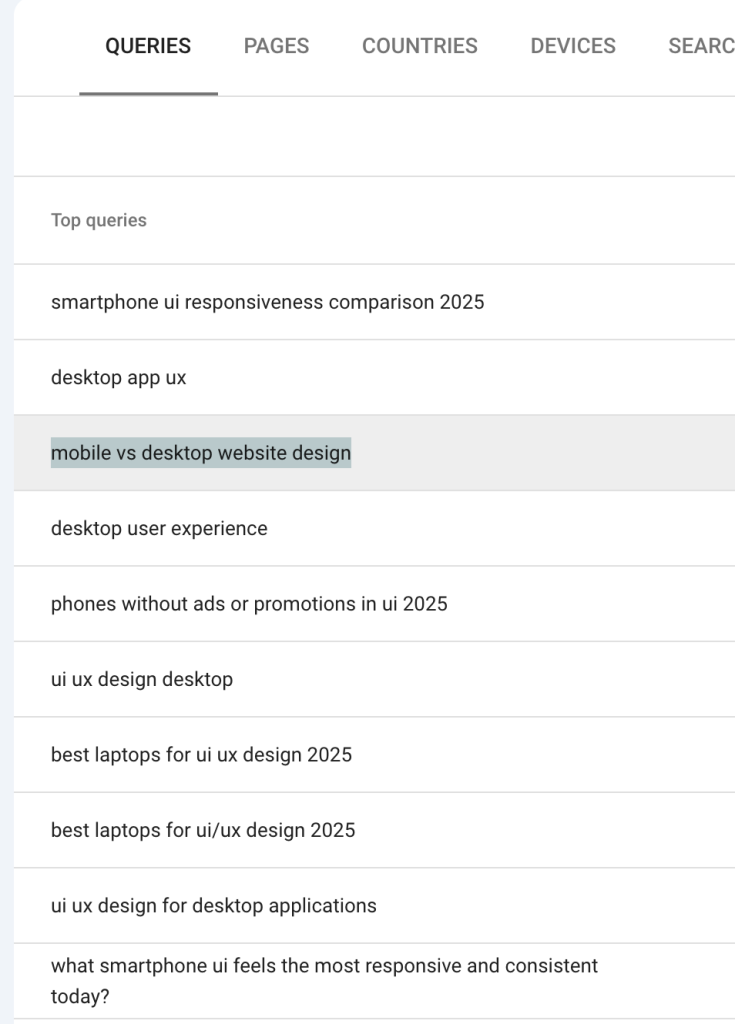
Through a simple experiment with the query ‘Mobile vs Desktop Website Design,’ we uncovered key questions such as:
- Is Digipixel content being cited in generative answers?
- Do keywords influence AI-generated results?
- Which types of queries increase the chance of citation?
The result confirmed that Digipixel was cited on Perplexity. If you want your website to appear in AI search engines, our team can help optimise your SEO and GEO strategies.
How Web Search work in AI Platforms?
To understand how AI search platforms respond to, summarise, or synthesise a user’s question, it is important to first recognise the technology driving this process, that is Generative AI.
What is Generative AI (GenAI)
Generative AI is a type of artificial intelligence that allows users to quickly create new content based on different inputs. These inputs and outputs can include text, images, audio, video, 3D models, or other forms of data.
How Generative AI (GenAI) Works?
Generative AI works by learning patterns from massive amounts of data and then creating new content, such as text, images, or summaries, in response to a user’s request. These systems are powered by foundation models, which act as the building blocks. For example, GPT-3 powers ChatGPT to generate written answers.
This same technology drives today’s AI search engines. Instead of just listing links like a traditional Google search, tools such as Google AI Overview, ChatGPT, Perplexity, and Claude use generative AI to produce a direct answer for the user. Within that answer, they may cite websites as their sources of information.
The most common and widely used form of Generative AI is language-based AI, since text is at the core of many generative models and remains the most advanced area of development. A leading example of this is Large Language Models (LLMs). LLMs power tools like ChatGPT, enabling them to perform a wide range of tasks with text
How Each GenAI tools work: Claude, ChatGPT, Perplexity and Google Gemini
Claude AI
Claude AI is a smart chatbot created to understand and respond to human language. It is built on what are called Large Language Models (LLMs) — the same kind of technology that powers tools like ChatGPT. In simple words, Claude is designed to read, understand, and write text in a way that feels natural and human-like.
People use Claude AI for a wide range of activities, such as:
- Answering questions and helping with research
- Proofreading, editing, or summarising documents (like PDFs and Word files)
- Writing content, translating languages, or even drafting business plans
- Generating and reviewing short pieces of code
- Processing images and audio — for example, creating product descriptions from pictures
Claude AI runs on a system called the transformer architecture, which is a type of neural network. In simple terms, it uses advanced mathematics to figure out the most likely and most relevant answer to a user’s question.
Here’s what that means in simple terms:
- Breaking down language
When you type a question, Claude does not see it as a full sentence. It breaks it into tiny pieces called tokens. A token might be a full word like “house” or part of a word like “ing” from “running”.
- Understanding meaning
Each token is placed into a kind of map that shows how closely related words are to each other. For example, “cat” and “dog” would appear close together because they are both animals. This helps Claude understand the meaning behind your words, not just the spelling.
- Finding the best answer
Claude then looks at your question, compares it with all the patterns it has learned during training, and predicts the most likely response. It does not know facts the way humans do. Instead, it uses probability and statistics to put together the most useful answer based on its training.
Claude can now search the internet directly when users ask a question. This allows it to provide more up-to-date and relevant answers. With web search, Claude can access the latest events and information, making its responses more accurate.
Here are the features of Claude’s Free Plan where a website has the chance to appear:
- Source websites are shown in the first row
- Generated answers include citation links as supporting references
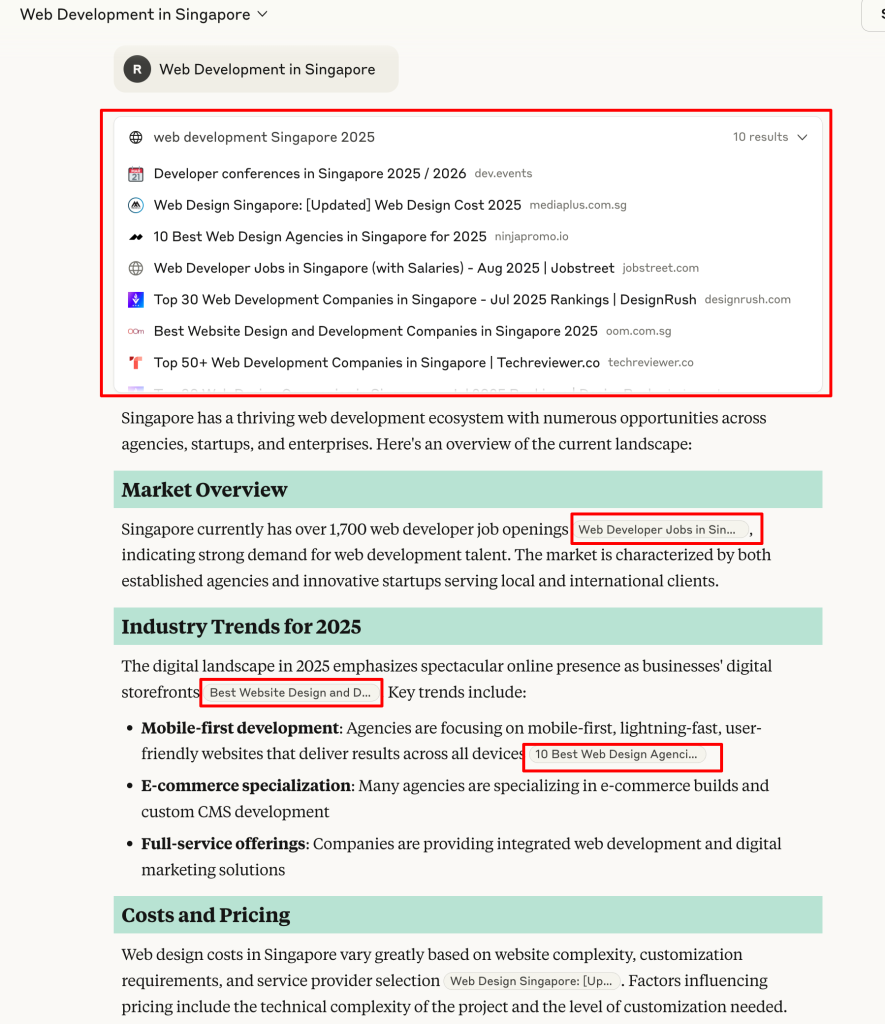
How Claude Selects and Cited Sources
Claude was running without updated web search capabilities until recently. Now with its newer versions, specific triggers can prompt it to fetch external sources and this creates opportunities for websites to be cited in its responses.
Queries that definitely trigger searching include:
- Current events, news, or recent developments (e.g., “What happened in the 2024 Olympics?” or “Latest AI developments”)
- Real-time data such as weather, stock prices, or current conditions
- Recently published studies, reports, or statistics
- Information about people, companies, or events that may have changed since Claude’s knowledge cutoff (January 2025)
- Direct requests to search or provide sources
- Technical details that change frequently or where Claude is uncertain about accuracy
Queries that usually don’t trigger searching include:
- Stable general knowledge (basic science facts, historical information, core programming principles)
- Established theories and explanations
- Standard how-to guides for common tasks
- Creative writing, personal advice, or opinion-based answers
- Math problems or logical reasoning exercises
Queries in the “gray area,” where Claude may or may not search, include:
- Evolving industry best practices
- Potentially outdated statistics
- Technical specifications that frequently change
We ran a simple experiment to test how these queries influence Claude’s responses. For example, when asking about “Mobile vs Desktop Website Design,” Claude relied mostly on general knowledge. This query didn’t trigger web searches because it was more timeless in nature and not tied to current trends.
However, when we updated the query to focus on 2025-specific developments—for instance, “smartphone ui responsiveness comparison 2025 ”—Claude was prompted to search the web. In this case, it not only generated a response but also cited websites.
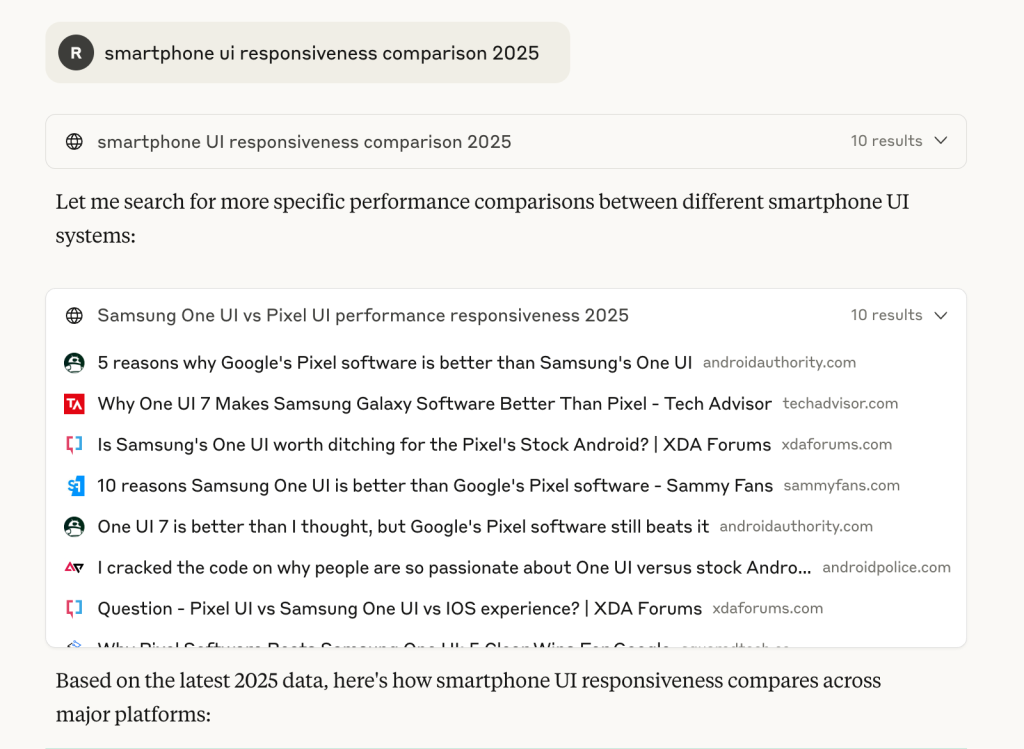
This demonstrates that context and time sensitivity play a key role in whether Claude cites external sources.
Perplexity
Claude and Perplexity both use advanced AI to interpret questions and understand the intent behind a query. The key difference is that Perplexity excels at web search and citation. It gathers information from trusted sources such as articles, websites, and journals, then presents these findings in a clear and easy-to-understand way.
Perplexity has also introduced Pro Search, which goes beyond standard search by delivering more detailed and comprehensive responses.
In addition, its Deep Research feature conducts dozens of searches automatically, reviews hundreds of sources, analyses the material, and produces a well-structured report within just 2–4 minutes.
Here are the features of Perplexity’s Free Plan where a website has the chance to appear:
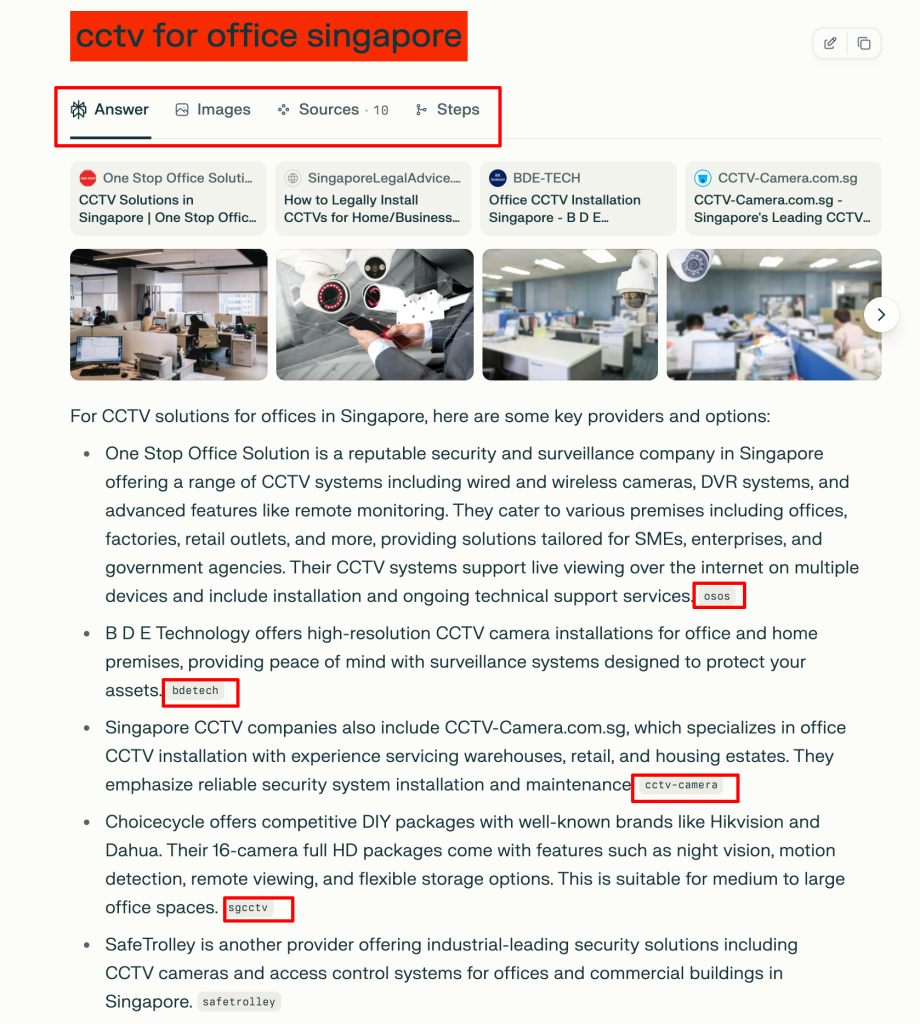
Answer tab: Displays the generative response to a query. Unlike Claude, which cites the title of a page or blog, Perplexity shows the website name directly. Both are clickable.
Images: Similar to Google, it presents related images that match the query.
Sources: Highlights the websites used to generate the answer and cites them within the Answer tab.
How Perplexity Selects and Cited Sources
We also conducted a simple experiment using the search query “Mobile vs Desktop Website Design.” The results included images, cited sources, and a generated answer, with the Digipixel blog featured among them.
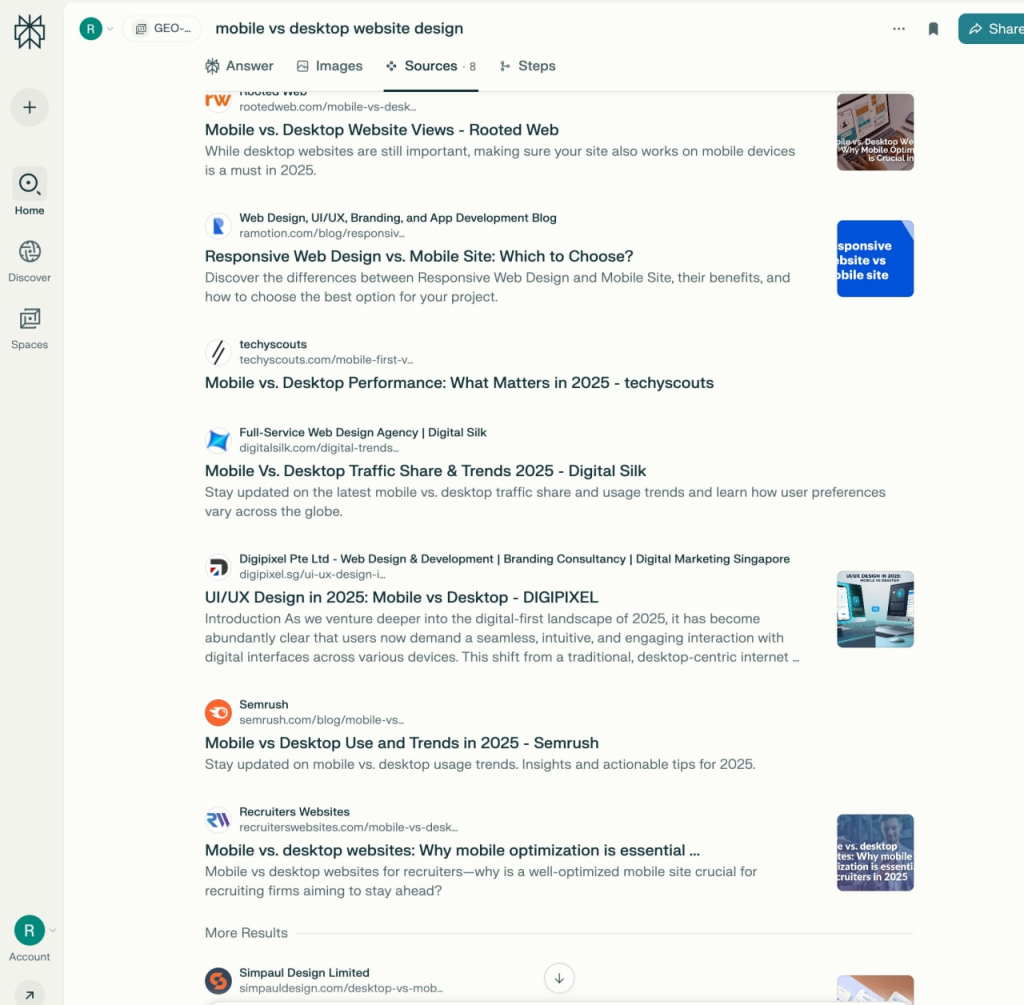
From this test, several key observations stand out:
- Perplexity cited sources using the exact query phrase “Mobile vs Desktop Website Design” word for word.
- LinkedIn appeared in the featured AI search results, but notably, it was not just a regular post—it was a blog-style article.
- Perplexity didn’t just cite content, it also displayed related images. This behavior is similar to Google Search, and upon inspection, the images came from websites where they were properly tagged with descriptive alt-text.


This experiment shows that Perplexity places strong emphasis on exact query matching, authoritative blog-style content, and well-optimised media such as images with alt text. For website owners, this highlights the importance of precise keyword usage, publishing in-depth articles, and ensuring accessibility features like alt text are in place. Together, these factors increase the likelihood of being cited within Perplexity’s AI-generated answers.
Chat GPT
ChatGPT was not originally designed as a search engine like Perplexity or Claude, but rather as a personal assistant. It relies on advanced natural language processing to understand questions and generate human-like responses, trained on data available up to a certain point. Its strengths lie in explaining concepts, creating summaries, or supporting brainstorming sessions.
As a result, ChatGPT does not cite websites directly. Instead, it draws on the general knowledge contained within its training data.
ChatGPT has explained how it gathers its answers, and interestingly, it does so in partnership with third-party search engines:
- Partnerships with search engines: ChatGPT sometimes partners with external search providers to deliver relevant answers such as Bing.
- Query rewriting: It rewrites your prompt into one or more targeted search queries before sending them to search providers.
Example: If a user asks, “What’s the best smartphone to buy this year?” - ChatGPT might first query using “best smartphones 2025 reviews” and then refine it with a follow-up like “iPhone 16 vs Samsung Galaxy S25 comparison.
- Use of general location data: ChatGPT collects general location information based on your IP address to improve results.
Example: If you ask “What are some good restaurants near me?” and your IP shows you’re in Singapore, ChatGPT may rewrite the query as “top restaurants Singapore.” - Privacy protections: ChatGPT does not share your IP address or any account information with third-party search providers. It only shares generalised location details when needed for context.
Pro tip: ChatGPT’s training data is updated periodically, though the exact schedule is not publicly disclosed. To increase your chances of being surfaced in its answers, it’s essential to publish blogs that build trust, cite credible sources, and demonstrate expertise through case studies and data-driven insights. Just as importantly, make sure every blog is indexed by Bing, since that is ChatGPT’s primary third-party search engine partner
Key Takeaways: How to Get Your Website Cited in AI Generative Search
- Publish fresh, up-to-date content: Focus on topics that trigger comparisons, reviews, or research-driven insights. Timely updates are crucial—include the year in your titles or tips to signal relevance. (For example: “Best SEO Tools for 2025” instead of a generic “Best SEO Tools.”)
- Use original visuals: Create authentic images, charts, and tables for your blogs. Avoid relying solely on stock photos from sites like Freepik. Unique visuals not only enhance credibility but also increase the chances of being featured in Claude’s or Perplexity’s results.
- Optimise image alt text: Every image should include descriptive alt text that clearly conveys its purpose. Incorporate relevant keywords and ensure the alt text answers potential user queries.
- Leverage professional and community platforms: Publish articles on LinkedIn and engage in discussions on platforms like Reddit by answering questions. Community-driven contributions often surface in AI-generated overviews from tools like Perplexity and Claude.
- Focus on intent-driven content: While keyword research is still valuable, the priority has shifted. Generative AI engines care less about traffic volume and more about how well your content answers the user’s query. Build your content strategy around solving problems and providing clear, direct answers.